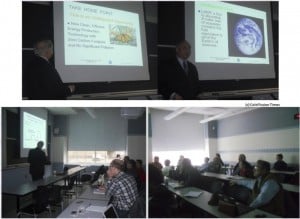Photo courtesy Cold Fusion Times.
Watch Cold Fusion 101 Week 1 lectures with Professor Peter Hagelstein here.
This video features course co-teacher Dr. Mitchell Swartz speaking on the experimental research done by his company JET Energy as they develop the NANOR cell.
Demonstration of Excess Heat from a JET Energy NANOR at MIT [.pdf] is a report by the course co-teachers summarizing the NANOR’s excess heat results from last year.
From Cold Fusion Times:
 Jan. 28, 2013 – On day 5, Dr. Mitchell Swartz continued with the substantial experimental proof for cold fusion (lattice assisted nuclear reactions). After discussion of the materials involved in the desired reactions, he surveyed the methods of calibration of heat producing reactions including the copious controls, time-integration, thermal waveform reconstruction, noise measurement and additional techniques, as well as those methods which are not accurate.
Jan. 28, 2013 – On day 5, Dr. Mitchell Swartz continued with the substantial experimental proof for cold fusion (lattice assisted nuclear reactions). After discussion of the materials involved in the desired reactions, he surveyed the methods of calibration of heat producing reactions including the copious controls, time-integration, thermal waveform reconstruction, noise measurement and additional techniques, as well as those methods which are not accurate.
Many examples of excess heat generated by CF/LANR systems were shown, using aqueous nickel and palladium systems. Then using the Navier Stokes equation, he developed the flow equations for both “conventional” cold fusion and codeposition. Optimal operating point operation was shown to have the ability to determine the products, and how the OOP manifolds demonstrate that CF is a reproducible phenomenon, applicable to science and engineering.
He focused on the salient advantages of the LANR metamaterials with the PHUSOR®-type system being one example. Returning to the experimental results and engineering methods developed to control cold fusion, he surveyed “heat after death” and its control and useful application, and the use of CF/LANR systems to drive motors.
DAY 5 Part 1
DAY 5 Part 2
DAY 5 Part 3

Jan. 29, 2013 – On day 6, Dr. Mitchell Swartz continued with the discussion of cold fusion (lattice assisted nuclear reactions) in aqueous systems, beginning with the near infra-red emissions from active LANR devices, and the use of CF to generate electricity. Problems in the feedback loop were discussed. Then the focus was on the new dry, preloaded nanomaterial CF/LANR materials.
After discussing their novel characteristics and electrical breakdown (avalanche) issues, and which electric drive regions actually generate excess energy, he presented the development of several types of the NANOR®-type CF electronic components. Using multiple ways of documenting the excess energy produced, he presented the results of the latest series of such devices, such as were shown at MIT over several months in the second series of open demonstrations of cold fusion by JET Energy, Inc.
With energy gains from 14 and greater, these electronic components, in conjunction with advanced driving circuits, were shown to have excess energy documented by temperature rise, heat flow, and calorimetry; heralding their revolutionary potential to change the energy landscape in circuits, distributed electrical power systems, artificial internal organs, propulsion systems, space travel, and more.
DAY 6 Part 1
DAY 6 Part 2
Related
Slide Set of NANOR®type output presented at MIT IAP Course 2012 [.pdf]
Conclusively Demonstrating the New Energy Effect of Cold Fusion by David French
Watch Dr. Peter Hagelstein lectures in order here.
An attendee summary from Dr. Bob Visits MIT

